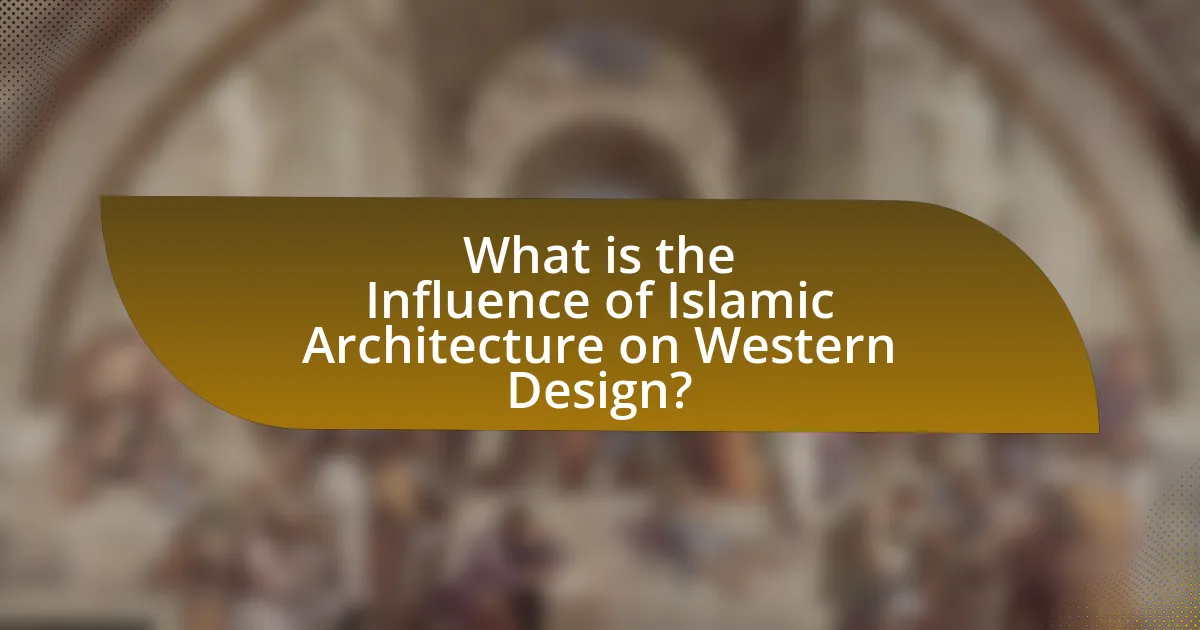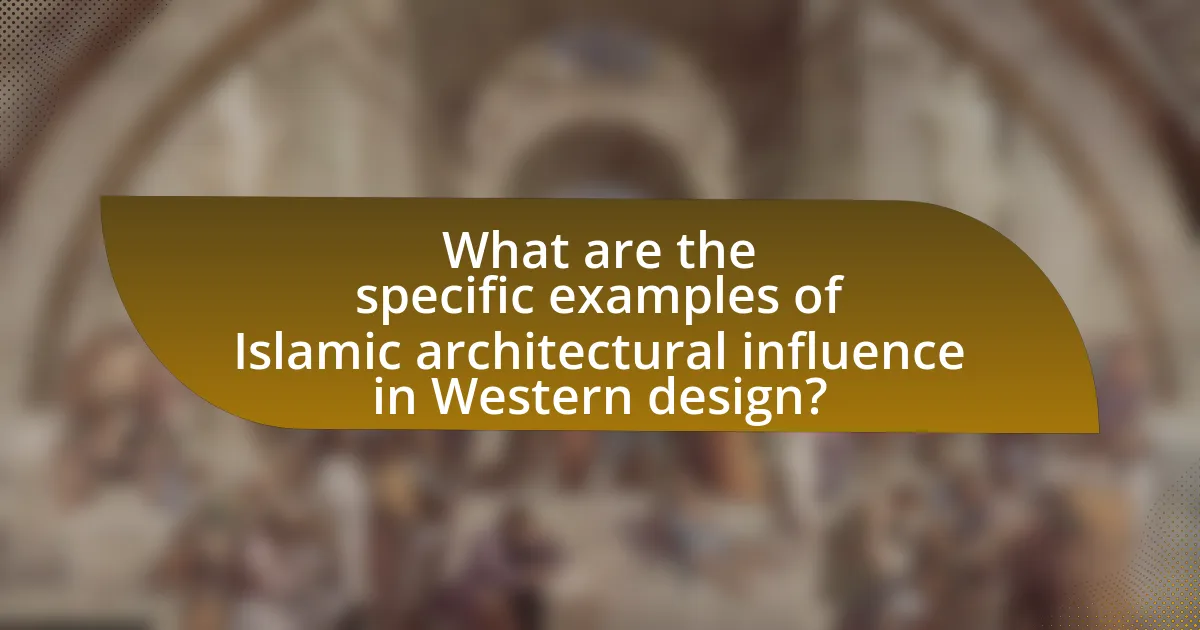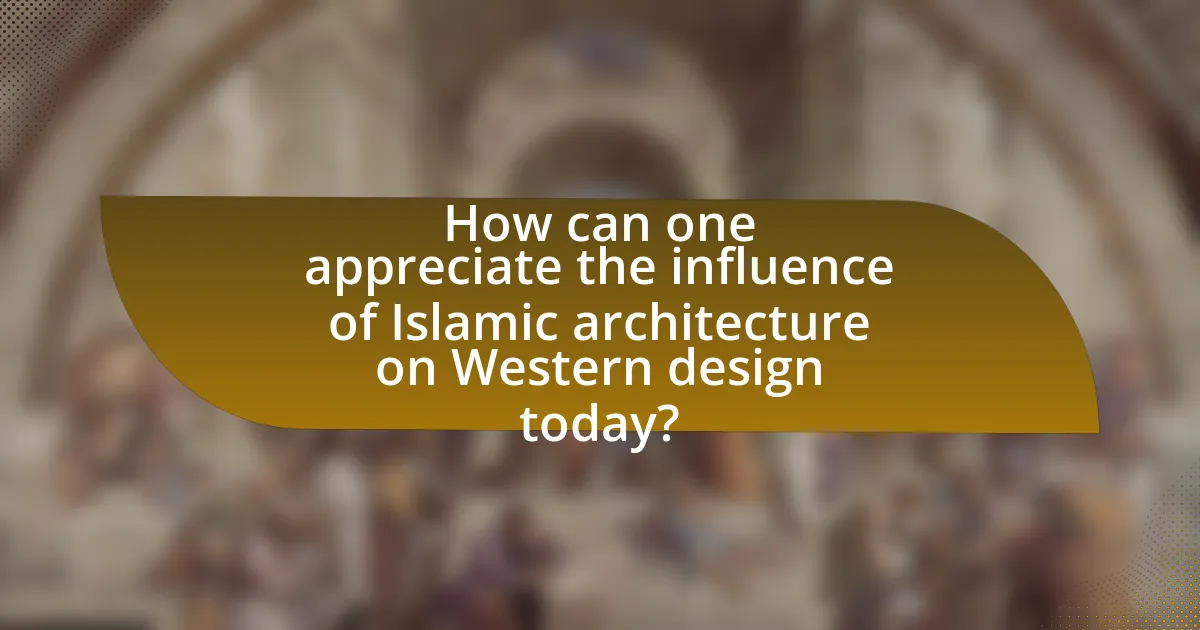The article examines the significant influence of Islamic architecture on Western design, highlighting key elements such as intricate geometric patterns, domes, arches, and ornamental tile work. It traces the origins and evolution of Islamic architecture from the 7th century, showcasing its integration of diverse cultural influences and its adaptation to local contexts. The discussion includes specific examples of how Islamic architectural features were adopted during the Renaissance, the role of historical events in shaping architectural styles, and the lasting impact on modern Western architecture. Additionally, the article emphasizes the importance of cultural exchanges, trade routes, and notable buildings that exemplify this architectural dialogue.

What is the Influence of Islamic Architecture on Western Design?
Islamic architecture has significantly influenced Western design through the introduction of intricate geometric patterns, the use of domes and arches, and the incorporation of ornamental tile work. This influence became particularly evident during the Renaissance when European architects, inspired by the architectural styles of the Islamic world, began to adopt these elements in their own buildings. For example, the Alhambra in Spain showcased elaborate tile work and arches that inspired structures like the Royal Palace of Madrid. Additionally, the use of courtyards and gardens in Islamic architecture informed the design of many Western public spaces, emphasizing harmony with nature. The exchange of ideas during the Crusades and trade routes further facilitated this architectural dialogue, leading to a lasting impact on Western aesthetics and building techniques.
How did Islamic architecture originate and evolve?
Islamic architecture originated in the 7th century with the rise of Islam, characterized by the integration of various cultural influences from the Arabian Peninsula, Byzantine, and Persian empires. The evolution of Islamic architecture is marked by the development of distinct architectural elements such as the mosque, characterized by features like domes, minarets, and intricate tile work, which became prominent in regions like Spain, North Africa, and the Middle East. Historical examples include the Great Mosque of Córdoba, built in the 8th century, which showcases the blending of Islamic and local architectural styles. Over time, Islamic architecture adapted to local contexts, leading to diverse expressions while maintaining core principles, such as the emphasis on geometric patterns and calligraphy, which reflect the cultural and religious values of the Islamic world.
What are the key characteristics of Islamic architecture?
Islamic architecture is characterized by its intricate geometric patterns, large domes, minarets, and the use of calligraphy and arabesques. These elements reflect the cultural and religious significance of the structures, often designed to create a sense of harmony and spirituality. For instance, the Great Mosque of Samarra features a spiraling minaret, while the Alhambra in Spain showcases elaborate tile work and gardens, illustrating the aesthetic principles of Islamic design. The emphasis on symmetry and the use of light and water in courtyards further enhance the architectural experience, demonstrating the integration of natural elements into built environments.
How did historical events shape Islamic architectural styles?
Historical events significantly shaped Islamic architectural styles through the confluence of cultural exchanges, conquests, and trade. The expansion of the Islamic Empire from the 7th century onward facilitated the incorporation of diverse architectural elements from conquered regions, such as Byzantine, Persian, and Indian influences, leading to a unique synthesis in design. For instance, the Umayyad Caliphate’s conquest of the Byzantine territories introduced the use of domes and arches, exemplified in the Great Mosque of Damascus, which features a blend of local and Byzantine styles. Additionally, the Silk Road trade routes enabled the exchange of ideas and materials, further enriching Islamic architecture with intricate tile work and calligraphy, as seen in the Alhambra in Spain. These historical interactions not only defined the aesthetic qualities of Islamic architecture but also established its enduring legacy, influencing Western design during the Renaissance and beyond.
What are the main elements of Islamic architecture that influenced Western design?
The main elements of Islamic architecture that influenced Western design include intricate geometric patterns, the use of domes and arches, and the incorporation of courtyards and gardens. These elements were adopted during the Renaissance period when Western architects encountered Islamic structures through trade and the Crusades. For instance, the use of large domes, as seen in the Hagia Sophia, was inspired by Islamic architecture, which emphasized grand, open spaces. Additionally, the decorative tile work and arabesques found in Islamic buildings inspired Western artists and architects to incorporate similar designs in their works, leading to a fusion of styles that characterized the period.
Which architectural features were adopted by Western designers?
Western designers adopted several architectural features from Islamic architecture, including intricate geometric patterns, the use of arabesques, and the incorporation of large domes and minarets. These elements were integrated into various styles, notably during the Renaissance and later periods, reflecting a blend of cultural influences. For instance, the Alhambra in Spain exemplifies the use of decorative tile work and elaborate stucco, which inspired Western architects to incorporate similar aesthetics in their designs. Additionally, the use of courtyards and gardens, as seen in Islamic architecture, became prominent in Western residential designs, promoting a connection with nature and enhancing spatial organization.
How did the use of geometric patterns impact Western aesthetics?
The use of geometric patterns significantly impacted Western aesthetics by introducing complexity and harmony in design, which was largely influenced by Islamic architecture. This influence became evident during the Renaissance when Western artists and architects began to incorporate intricate geometric designs into their works, enhancing visual appeal and structural coherence. For instance, the Alhambra in Spain, with its elaborate tile work and patterns, served as a model for Western designers, leading to the adoption of similar motifs in various art forms, including textiles and ceramics. This cross-cultural exchange not only enriched Western aesthetics but also fostered a greater appreciation for mathematical precision and symmetry in art and architecture.
Why is the study of Islamic architecture important for understanding Western design?
The study of Islamic architecture is crucial for understanding Western design because it reveals the historical and cultural exchanges that shaped architectural practices in the West. Islamic architecture introduced key elements such as intricate geometric patterns, the use of light and space, and innovative structural techniques, which influenced European architects during the Renaissance. For instance, the Alhambra in Spain exemplifies how Islamic design principles were integrated into Western architecture, leading to the development of styles like Mudejar and later Baroque. This cross-cultural interaction highlights the significance of Islamic architecture as a foundational influence on Western design, demonstrating how architectural ideas transcend geographical boundaries and evolve through cultural dialogue.
What cultural exchanges facilitated the influence of Islamic architecture?
Cultural exchanges that facilitated the influence of Islamic architecture include trade routes, conquests, and the movement of scholars and artisans. The Silk Road, for instance, enabled the transfer of architectural techniques and styles between the Islamic world and regions such as Europe and Asia. The Umayyad and Abbasid caliphates expanded their territories, incorporating diverse cultures and architectural practices, which led to the synthesis of styles. Additionally, the translation movement in the House of Wisdom in Baghdad during the 8th to 10th centuries allowed for the sharing of knowledge, including architectural principles from Greek and Roman sources, which were adapted into Islamic architecture. These exchanges resulted in the development of distinctive features such as intricate geometric patterns, large domes, and minarets, which influenced Western architectural designs during the Renaissance and beyond.
How did trade routes contribute to architectural knowledge transfer?
Trade routes significantly contributed to architectural knowledge transfer by facilitating the exchange of ideas, techniques, and materials between cultures. For instance, the Silk Road connected the Islamic world with Europe and Asia, allowing architects and builders to share innovations such as the use of arches, domes, and intricate tile work. Historical evidence shows that the introduction of Islamic architectural elements, like the horseshoe arch and muqarnas, influenced Gothic cathedrals in Europe, demonstrating a direct transfer of knowledge. Additionally, trade routes enabled the movement of skilled artisans who brought their expertise to new regions, further enhancing architectural practices.

What are the specific examples of Islamic architectural influence in Western design?
Islamic architectural influence in Western design is exemplified by the Alhambra in Spain, the Great Mosque of Cordoba, and the use of intricate tile work and geometric patterns in various European buildings. The Alhambra, built in the 13th century, showcases Islamic aesthetics through its ornate stucco work and gardens, influencing the Renaissance architecture in Spain. The Great Mosque of Cordoba, with its horseshoe arches and elaborate mosaics, served as a model for later European churches. Additionally, the incorporation of Islamic motifs, such as arabesques and calligraphy, can be seen in the design of the Royal Pavilion in Brighton and the Victoria and Albert Museum in London, highlighting the lasting impact of Islamic architecture on Western design.
How did the Renaissance period reflect Islamic architectural elements?
The Renaissance period reflected Islamic architectural elements through the incorporation of features such as intricate geometric patterns, large domes, and the use of arabesques. These elements were adopted as European architects encountered Islamic architecture during the Crusades and through trade, leading to a fusion of styles. For example, the use of pointed arches and elaborate tile work in structures like the Alhambra influenced Renaissance buildings, including the Florence Cathedral, which showcases a dome inspired by Islamic designs. This blending of aesthetics demonstrates the significant impact of Islamic architecture on the evolution of Western design during the Renaissance.
What buildings exemplify this influence during the Renaissance?
The Alhambra in Spain exemplifies the influence of Islamic architecture on Western design during the Renaissance. This palace and fortress complex showcases intricate tile work, ornate stucco, and elaborate arches, which significantly inspired Renaissance architects. Additionally, the Great Mosque of Córdoba, with its horseshoe arches and expansive courtyard, served as a model for the integration of Islamic elements into European structures. These buildings highlight the cross-cultural exchange that shaped Renaissance architecture, demonstrating the lasting impact of Islamic design principles on Western aesthetics.
How did Islamic motifs appear in Renaissance art and architecture?
Islamic motifs appeared in Renaissance art and architecture primarily through cultural exchange and trade between Europe and the Islamic world. This interaction facilitated the introduction of intricate geometric patterns, arabesques, and calligraphy into European artistic practices. For instance, the importation of textiles, ceramics, and manuscripts from the Islamic regions influenced artists such as Raphael and Michelangelo, who incorporated these designs into their works. Additionally, the architectural features of mosques, such as domes and minarets, inspired the design of churches and public buildings in Renaissance Italy, exemplified by the dome of Florence Cathedral, which reflects Islamic architectural principles. The presence of Islamic motifs in Renaissance art and architecture underscores the significant impact of cross-cultural interactions during this period.
What role did Islamic architecture play in the development of modern Western architecture?
Islamic architecture significantly influenced the development of modern Western architecture by introducing innovative design elements such as intricate geometric patterns, large domes, and expansive courtyards. These features were adopted during the Renaissance when European architects encountered Islamic structures through trade and the Crusades, leading to a fusion of styles. For instance, the use of pointed arches and elaborate tile work in Gothic cathedrals reflects this influence. Additionally, the principles of spatial organization and light manipulation found in Islamic architecture can be seen in modern Western buildings, emphasizing functionality and aesthetic appeal. The incorporation of these elements demonstrates the lasting impact of Islamic architecture on Western design practices.
Which contemporary architects draw inspiration from Islamic design?
Contemporary architects who draw inspiration from Islamic design include Zaha Hadid, who incorporated fluid forms and intricate patterns reminiscent of Islamic art in her works, and Hassan Ragab, known for blending traditional Islamic elements with modern architecture. Additionally, Kengo Kuma has integrated Islamic motifs into his designs, emphasizing harmony with nature and cultural context. These architects demonstrate the ongoing influence of Islamic architecture through their innovative approaches, reflecting its aesthetic and cultural significance in contemporary design.
How have Islamic architectural principles been integrated into modern buildings?
Islamic architectural principles have been integrated into modern buildings through the incorporation of geometric patterns, intricate tile work, and the use of courtyards and gardens. These elements reflect the aesthetic and functional aspects of traditional Islamic architecture, promoting harmony with nature and community interaction. For instance, the use of large, open spaces and natural light in contemporary designs echoes the traditional Islamic emphasis on light and ventilation, as seen in structures like the King Abdulaziz Center for World Culture in Saudi Arabia, which features expansive atriums and intricate facades. Additionally, modern architects often draw inspiration from Islamic motifs and calligraphy, as demonstrated in the design of the Museum of Islamic Art in Qatar, which showcases a blend of modern materials with traditional Islamic forms.

How can one appreciate the influence of Islamic architecture on Western design today?
One can appreciate the influence of Islamic architecture on Western design today by examining the incorporation of key elements such as intricate geometric patterns, large domes, and expansive courtyards in contemporary buildings. For instance, the use of arabesque motifs and calligraphy in modern architecture reflects the aesthetic principles established in historic Islamic structures, like the Alhambra in Spain and the Great Mosque of Samarra. Additionally, the integration of light and space, as seen in the works of architects like Zaha Hadid, showcases a direct lineage to Islamic architectural practices that prioritize natural light and fluidity in design. This influence is further evidenced by the prevalence of Islamic architectural styles in public buildings and cultural institutions across Europe and North America, highlighting a lasting legacy that continues to shape architectural discourse today.
What are some practical ways to explore this architectural influence?
To explore the influence of Islamic architecture on Western design, one can visit historical sites that showcase this architectural style, such as the Alhambra in Spain or the Great Mosque of Cordoba, which exemplify the intricate designs and motifs characteristic of Islamic architecture. Engaging in architectural tours or workshops focused on Islamic design principles can provide hands-on experience and deeper understanding. Additionally, studying architectural texts and scholarly articles that analyze the cross-cultural exchanges between Islamic and Western architecture, such as “Islamic Architecture: Form, Function, and Meaning” by Robert Hillenbrand, can offer valuable insights into the historical context and design elements that have influenced Western architecture.
Which museums or sites showcase the blend of Islamic and Western architecture?
The museums and sites that showcase the blend of Islamic and Western architecture include the Alhambra in Spain, the Hassan II Mosque in Morocco, and the Museum of Islamic Art in Qatar. The Alhambra, a UNESCO World Heritage site, features intricate Islamic art and architecture combined with Renaissance elements, reflecting the historical coexistence of cultures in Spain. The Hassan II Mosque, one of the largest mosques in the world, incorporates modern architectural techniques while adhering to traditional Islamic design principles. The Museum of Islamic Art in Qatar, designed by I.M. Pei, merges contemporary architecture with Islamic aesthetics, showcasing the influence of Islamic design on modern structures.
How can architectural tours enhance understanding of this influence?
Architectural tours can enhance understanding of the influence of Islamic architecture on Western design by providing firsthand exposure to key architectural elements and historical contexts. These tours often highlight specific features such as intricate tile work, arches, and geometric patterns that originated in Islamic architecture and were later adopted in Western styles. For instance, the Alhambra in Spain showcases how Islamic design principles influenced the Renaissance architecture of Europe, illustrating the cross-cultural exchange that occurred during the Reconquista. By experiencing these sites directly, participants can better appreciate the aesthetic and functional aspects of Islamic architecture that have permeated Western design, thereby deepening their comprehension of this historical influence.
What resources are available for further study on this topic?
Resources available for further study on the influence of Islamic architecture on Western design include academic books, journal articles, and online databases. Notable books such as “Islamic Architecture: Form, Function, and Meaning” by Robert Hillenbrand provide in-depth analysis and context. Additionally, the journal “The Journal of Islamic Architecture” publishes peer-reviewed articles that explore various aspects of this influence. Online databases like JSTOR and Google Scholar offer access to numerous scholarly articles and research papers on the topic, facilitating comprehensive study.
Which books or articles provide in-depth analysis of Islamic architecture’s impact?
Books and articles that provide in-depth analysis of Islamic architecture’s impact include “Islamic Architecture: Form, Function, and Meaning” by Robert Hillenbrand, which explores the cultural and historical significance of Islamic architectural forms. Another key work is “The Islamic Architectural Heritage: A World Perspective” by Michael Rogers, which examines the global influence of Islamic architecture on various design practices. Additionally, “The Influence of Islamic Art and Architecture on Western Design” by Richard Ettinghausen offers insights into how Islamic aesthetics have shaped Western architectural styles. These sources collectively highlight the profound impact of Islamic architecture on global design paradigms.
How can online platforms facilitate learning about architectural influences?
Online platforms can facilitate learning about architectural influences by providing accessible resources, interactive content, and collaborative tools. These platforms offer a wide range of materials, such as virtual tours of significant architectural sites, online courses, and webinars that focus on the impact of Islamic architecture on Western design. For instance, platforms like Coursera and edX host courses that explore historical contexts and architectural styles, allowing learners to engage with expert insights and peer discussions. Additionally, social media and forums enable users to share knowledge, ask questions, and connect with professionals in the field, enhancing the learning experience through community engagement.
